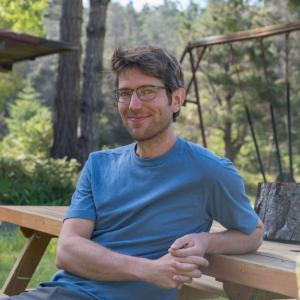Notes from the Director, Fall 2020

William Ratcliff, Co-Director of the Interdisciplinary Graduate Program in Quantitative Biosciences
Expanding QBioS leadership, celebrating our community's successes, and avoiding the 'intuition nightmare'
We have recently expanded the leadership team at QBioS. Joining founding director Joshua Weitz, I will serve as Co-Director, and am also joined by JC Gumbart, who will serve as Associate Director. I am excited for this role because I deeply believe in both QBioS’s mission, using quantitative tools to make fundamental biological insight, and in the program itself, which is innovative, student-focused, and rigorous. In general terms, Joshua will focus on strategy and programmatic innovation, I will concentrate on our students, and JC will provide post-graduate school career mentorship and lead the spring modeling workshops.
It is our pleasure to welcome seven new PhD students to QBioS, some of whom made it here to Atlanta through feats that were nothing short of heroic. This year is doubly significant: our first cohort of nine students, who arrived in 2016, are beginning their fifth and final year of their PhDs. We are greatly looking forward to celebrating their accomplishments as they defend their dissertations.
Quantitative reasoning offers a clear path through what journalist Ed Yong calls the ‘intuition nightmare’. Intuition often generates simple explanations for complex phenomena. In his piece, Ed wrote about US policy regarding COVID-19, showing how we moved linearly from solution to solution, failing to control the virus. By hoping that any single factor would be enough to contain the virus, we missed out on the more complex reality that interactions among interventions are important. The same logical fallacy is endemic in biological research.
Most experiments in biology start with the intuition (formalized as a hypothesis) that x will affect y in some way. The standard experiment to test this hypothesis varies x (which could be drug dose, habitat density, temperature, etc.) and examines its effect on y. If the experiment fails, researchers often move on to the next hypothesis, and the cycle repeats. Yet many biological phenomena are intrinsically multivariate and non-additive, just as society-scale solutions to COVID-19 appear to be; making insight into these systems requires a quantitative approach. This is precisely what QBioS students are doing, from explaining the neuroscience of insect flight, to studying the evolutionary origins of complex life, to using machine learning to improve bioinformatic predictions.
While we face many challenges in the coming year, I remain filled with hope. Our community has stayed closely connected, providing essential social and scientific support. QBioS students and faculty are doing critical work on COVID-19, playing a central role in protecting the entire GT community by developing the COVID-19 surveillance program and a risk-management tool that is used around the country. At the same time, our students continue to pursue important basic research. In the last several months, Daniel Lauer and Rozenn Pineau have shown how that habitat stability in North America is at a 15,000-year low, increasing recovery time and signaling a wave of future extinctions. Guanlin Li has examined why bacterial viruses vary from beneficial to lethal. Daniel Muratore has written a primer for researchers analyzing microbiome time series data. And both Pedro Márquez-Zacarías and Rozenn Pineau wrote a review on how to merge data with theory when studying the evolution of cellular differentiation. Every student has been affected by this pandemic, and I am remain deeply impressed with their resiliency as they continue to make fundamental scientific discoveries, teach, and learn.
